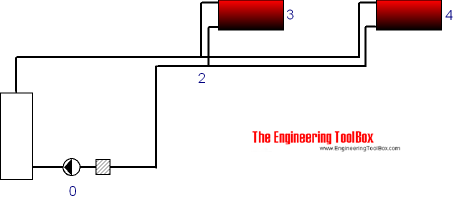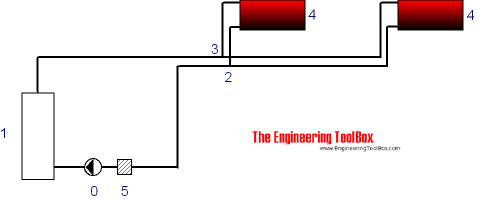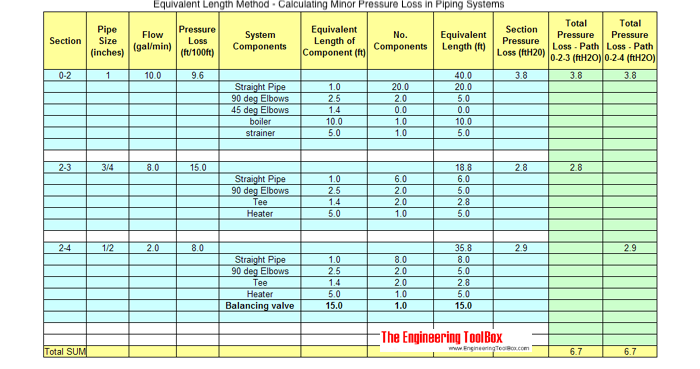Equivalent Length Method - Minor Pressure Loss in Piping Systems
Calculate minor pressure loss in piping systems with the Equivalent Pipe Length Method.
An efficient and simple way to calculate the pressure loss in a piping system is the "Equivalent Pipe Length Method".
1. Make a Diagram of the Piping System
Make a diagram where the system is structured with nodes as shown below.

In the very simply circulating system used in this example the first node (0) is the pump. The next node is the tees (2) where the piping system splits up. The other nodes are the heating radiators.
In many systems the structure can be simplified as above since the piping in both directions are of same size. If a more fine grained approach is required, additional nodes can be added in both directions as shown below.

2. Make a calculation table
With the most simplified nodes structure above a calculation table can be made as shown below. Each section from node to node is calculated by supplying length, volume flow, pipe size, pressure loss from diagrams or tables for the actual pipes and components in the sections and their individual equivalent length substituting the the minor loss.

An excel template with the table above can be downloaded here:
Note! The flow and pressure units must be adjusted to the data available for your piping system.
3. Add Volume flow, Pipe Size and Pressure Loss for each Section
Add actual pipe size and in each section. Use tabulated data or a diagrams.
The pressure loss may alternatively be calculated with the Hazen-Williams Equation or the Darcy-Weisbach Formula.
- Pressure loss for many types of pipes can be found here.
4. Add Equivalent Length of all Valves, Fittings and Straight Pipes
Add the equivalent length of all valves, components, fittings and straight pipes in the sections.
5. Summarize the Pressure Loss in each Section
Calculate and summarize the pressure loss in each section.
6. Summarize the Pressure Loss in all Paths
Finally, add up the pressure loss in all sections that form unique paths. In the example above there are two unique paths - one is section 0 - 2 - 3, the other is section 0 - 2 - 4. Add extra columns for additional paths in more complicated systems.
The highest pressure loss determines the pump head.
7. Add Balancing Valves
Add valves where it is necessary to balance the system. In the example above a balancing valve is added in section 2-4.
Note! The Equivalent Pipe Length Method can be adapted to most piping systems - like water supply systems, gravity heating systems and similar.
Related Topics
-
Design Strategies for Piping Systems
Piping systems design strategies - documentation, P&ID, flow diagrams - capacities and limits. -
Fluid Flow and Pressure Loss in Pipes and Tubes
Fluid flow and pressure loss in pipe lines. Water and sewer systems. Steel pipes, pvc pipes, copper tubes and more. -
Heating Systems
Design of heating systems - capacities and design of boilers, pipelines, heat exchangers, expansion systems and more.
Related Documents
-
Copper Tubes - Equivalent Length Pressure Loss in Fittings and Valves
Copper tube fittings and equivalent lengths - in feets of straight tube. -
Darcy-Weisbach Equation - Major Pressure and Head Loss due to Friction
The Darcy-Weisbach equation can be used to calculate the major pressure and head loss due to friction in ducts, pipes or tubes. -
Duct Sizing - the Equal Friction Method
The equal friction method for sizing air ducts is easy and straightforward to use. -
Equivalent Diameter - Rectangular vs. Circular HVAC Ducts
Rectangular equivalent diameter for air flows between 100 - 50000 cfm. -
Fluid Flow - Equivalent Diameter
Convert rectangular and oval duct geometry to a equivalent circular diameter - online calculator with imperial and SI-units. -
Hazen-Williams Friction Loss Equation - calculating Head Loss in Water Pipes
Friction head loss (ftH2O per 100 ft pipe) in water pipes can be estimated with the empirical Hazen-Williams equation. -
Hot Water Heating Systems - Online Design Application
Free online design tool for designing hot water heating systems - metric units. -
Hot Water Heating Systems - Online Design Application, Imperial Units
Online design tool for hot water heating systems. -
Hot Water Systems - Equivalent Length vs. Fittings Resistance
Equivalent length of fittings like bends, returns, tees and valves in hot water heating systems - equivalent length in feet and meter. -
Pipe and Tube System Components - Minor (Dynamic) Loss Coefficients
Minor loss coefficients for components used in pipe and tube systems. -
Pipe Lengths
Pipe is supplied and refered to as single random, double random or cut lengths -
PVC Pipes - Equivalent Length and Pressure Loss in Fittings
Minor loss in PVC and CPVC fittings expressed as equivalent length of straight pipe. -
PVC Pipes Schedule 80 - Friction Loss vs. Water Flow
Water flow in thermoplastic PVC and CPVC pipes Schedule 80 - friction loss (ft/100 ft, psi/100 ft) and flow velocities at dimensions ranging 1/2 to 16 inches.




